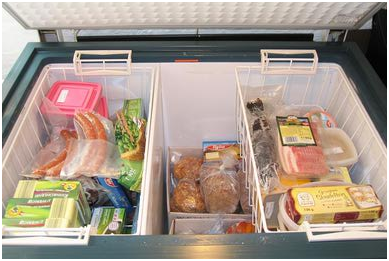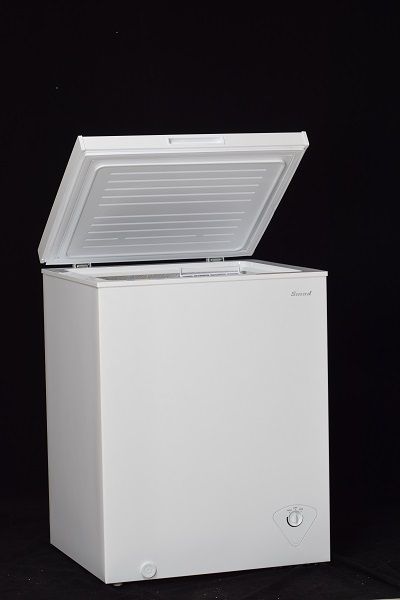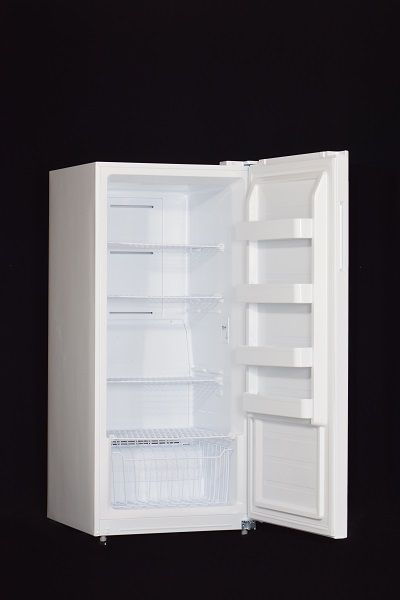
Although a refrigerator freezer may provide sufficient frozen food storage for a small family, a chest or upright freezer can be very convenient and can even save you money in the long run. Having ample freezer storage allows you to take advantage of bulk food specials, freeze seasonal berries and jams, as well as everyday and special event baking, make-ahead meals and wild game or large meat orders.
What style of freezer should you buy and what will work better for you? There are trade-offs to each type of freezer - you have to choose based on freezer price, capacity, conveniences, energy efficiency and freezer installation. Both styles of freezers are generally sold in 5 - 25 cu. ft. sizes, but there are capacity differences in the same size chest and upright models of freezers. It's easier to find the mid-range freezer sizes in stores and not all freezers are available in self-defrost models.
Having a freezer (or two) in your home can add another dimension worth considering. Instead of having a refrigerator/freezer in your kitchen, you could choose an all-refrigerator model which would greatly increase cold food storage, and keep your frozen foods in one or two freezers. It should be noted however, that freezers will increase your energy costs while providing this food storage convenience.

Chest Freezers
Price, Capacity & Energy:
The most economical type of freezer is the chest model. Basically every inch of a chest freezer is usable storage. Although there are certain chest models that have automatic defrost or are frost-free, most chest freezers are manual defrost, a task which requires several hours or a whole day to accomplish.
Because of the built-in side wall insulation, chest freezers hold their cold temperatures very well and therefore use the least energy to run. In fact, during a power outage or a household move to another locale, as long as the freezer lid is not open, an unplugged chest freezer can keep the contents frozen for 2 or even 3 days, depending on the frozen food quantity. Manual chest freezers tend to have longer lifecycles than upright models.
Freezer Convenience Features:
Chest freezers usually come with at least one wire basket to help you organize the contents. You can segregate types of foods using cardboard boxes to better organize freezer contents. However, chest freezers require a lot of bending, reaching and moving frozen foods to find what you're looking for.
That being said, they do accommodate odd-shaped, long or large items which may be difficult to place in an upright freezer. There are some models on the market that have a bottom drawer accessible from the outside of the chest freezer, but while this can add convenience to a chest model, it will also reduce capacity slightly.
Freezer Installation Requirements:
Because of the width of a chest freezer, which will vary depending on the size, it's footprint is larger than what is needed for an upright model, even for a small chest freezer. You'll need to ensure that there is enough space to place it and sufficient head room above the freezer to fully open the door.
Check measurements before buying to ensure you have a spot for it. It's worth mentioning that when choosing a chest freezer, you should consider the path to and inside the house, how many turns or doorways you'll need to go through to get it in place. Although chest models are now made slightly narrower than years ago, it's not unusual to have to remove a door or two to get it inside the house and beyond. Always locate a freezer in a dry level area.

Upright Freezers
Price, Capacity & Energy:
Upright freezers are more expensive than chest models yet provide less usable storage capacity; a difference of about 10 - 15% less. Prices are influenced by capacity and storage systems, as well as convenience features like auto or manual defrost. It can be hard to detect whether an upright has self defrost or not, you'll need to confirm that with the dealer.
This feature can cost you a $100 or more plus it will use more energy, but the convenience is well worth this extra cost. An auto defrost feature in an upright works similar to a refrigerator auto-defrost by cycling off/on to keep the freezer free of ice build-up.
Convenience Features:
Probably the best convenience feature of an upright freezer is the ability to better organize the frozen foods, making it easier to monitor and rotate contents to keep frozen foods current. Some upright models have versatile storage systems with adjustable and removable door storage bins, sliding and adjustable shelving and pull out baskets or bins.
All these features add to the ease of sorting and storing contents. Although you can better organize an upright, there are constraints. Items such as large turkeys or long frozen items may not fit without removing a shelf to accommodate the size.
Installation Requirements:
An upright freezer has a smaller footprint than chest models. Think in terms of placing a refrigerator when considering a location for an upright freezer. It needs room for height as well as width, door swing space and at least 1" behind it. Also consider which way the door swings and whether it is reversible.
Which is Better - a Chest or Upright Freezer?
If you can afford the extra cost and you love to keep everything organized in its place - an upright may be best for you. If you're just looking for economical frozen food storage, a chest is cheap to buy and operate. The type of freezer that best suits you also depends on your particular lifestyle and needs. Some people prefer to have an upright for everyday frozen foods while they store seasonal game/meat or special baking in a chest freezer. For the best energy efficiency, choose a freezer that is Energy Star Qualified .


